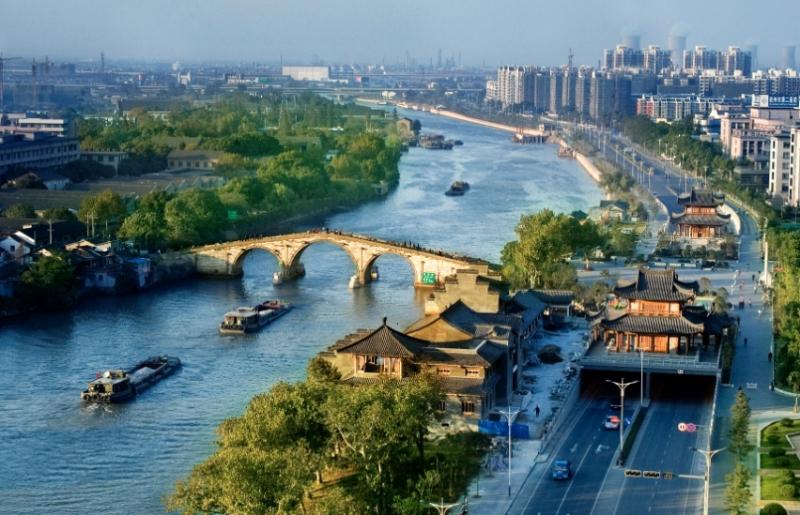Beijing-Hangzhou Grand Canal

I. History and Culture
1.1 Construction and Evolution:
- 1.1.1 Origin: In 486 BC, King Fuchai of Wu dug the initial Han Canal, connecting the Yangtze River and the Huai River, laying the foundation for the Grand Canal.
- 1.1.2 Construction Throughout the Dynasties: Successive dynasties, including Qin, Sui, Tang, Song, Yuan, Ming, and Qing, all constructed and expanded the Grand Canal, continuously improving its functionality and scale.
- 1.1.3 Final Formation: During the Yuan Dynasty, the various sections of the canal in the north and south were connected, forming a massive waterway spanning the north and south, eventually named "Beijing-Hangzhou Grand Canal."
1.2 Economic and Social Impact:
- 1.2.1 Water Transport Hub: The Grand Canal connected the economic centers of the north and south of China, becoming a crucial transportation route for goods, fostering economic exchange and development between the two regions.
- 1.2.2 Grain Transport Center: The Grand Canal served as the primary route for grain transport in successive dynasties, carrying the weight of grain transportation and ensuring the food supply of the capital.
- 1.2.3 Cultural Exchange: The Grand Canal promoted cultural exchange between the north and south, disseminating knowledge and technology, driving the flourishing development of Chinese civilization.
1.3 Cultural Heritage:
- 1.3.1 Historical Sites and Landscapes: Along the Grand Canal, numerous ancient historical sites remain, such as ancient cities, bridges, and docks, representing valuable relics of Chinese civilization.
- 1.3.2 Folk Tales: Folk tales and legends associated with the Grand Canal reflect the lives and wisdom of ancient working people, becoming an integral part of Chinese culture.
- 1.3.3 Literature and Art: The Grand Canal served as a source of inspiration for countless scholars and artists throughout history. Many poems, paintings, and dramatic works have the Grand Canal as their theme, showcasing its historical character and cultural essence.
II. Engineering and Technology
2.1 Water Control Engineering:
- 2.1.1 Sluice Gates: Numerous ancient sluice gates were built along the Grand Canal to regulate water flow and prevent flooding, demonstrating the advanced level of ancient water control engineering.
- 2.1.2 Embankments: The embankments on both sides of the Grand Canal effectively prevented flooding, ensuring the smooth flow of the canal and agricultural production.
- 2.1.3 Water Diversion Projects: The construction of the Grand Canal involved numerous water diversion projects, such as the diversion of the Yellow River to the Huai River and the diversion of the Yangtze River to the Huai River, showcasing the wisdom and creativity of ancient people.
2.2 Canal Vessels:
- 2.2.1 Types: The Grand Canal utilized a variety of vessels, including grain ships, passenger ships, cargo ships, designed according to their purpose and loading capacity.
- 2.2.2 Technology: The construction techniques of ancient ships were sophisticated, employing wooden structures and sailing technology, showcasing the craftsmanship and wisdom of ancient artisans.
- 2.2.3 Transportation Methods: Transportation on the Grand Canal was primarily powered by human labor, but also utilized sailboats and animal traction, reflecting the evolution of ancient transportation methods.
III. Contemporary Significance
3.1 Tourism Resources:
- 3.1.1 Historical Sites: The abundance of historical sites along the Grand Canal represents a significant tourism resource, attracting domestic and international visitors.
- 3.1.2 Canal Scenery: The Grand Canal's picturesque natural scenery provides a relaxing and enjoyable destination for people seeking leisure and vacation.
- 3.1.3 Cultural Experience: The folk culture and traditional crafts along the Grand Canal offer visitors unique cultural experiences.
3.2 Economic Development:
- 3.2.1 Water Transport: The Grand Canal still holds significant importance for water transport, providing convenience for economic development in the surrounding regions.
- 3.2.2 Tourism Development: The development of Grand Canal tourism has boosted the economic growth of the surrounding regions and created job opportunities.
- 3.2.3 Cultural Industry: The development of the Grand Canal cultural industry has fostered the flourishing of industries like cultural creativity and cultural dissemination.
3.3 Cultural Transmission:
- 3.3.1 Protecting Heritage: Protecting the historical sites and cultural heritage of the Grand Canal is a crucial responsibility in preserving Chinese civilization.
- 3.3.2 Transmitting Culture: Through various means, the Grand Canal culture should be transmitted to ensure its longevity as a spiritual treasure of the Chinese nation.
- 3.3.3 Cultural Exchange: Utilizing Grand Canal culture to strengthen international cultural exchange and foster understanding and friendship among peoples worldwide.
Conclusion:
The Beijing-Hangzhou Grand Canal is a masterpiece of ancient Chinese engineering and a precious relic of Chinese civilization. It stands as a testament to the prosperity of ancient Chinese society and has bequeathed a wealth of cultural riches for posterity. Today, we must continue to pass on and develop Grand Canal culture, transforming it into a world-renowned cultural brand, contributing to the great rejuvenation of the Chinese nation.